GEORGE III PARTRIDGE WOOD COMPENDIUM GAMING TABLE English. Circa 1800. Measurements: Height: 29 3/4″ (75.6 cm) Width: 21 3/4″ (55.2 cm) Depth: 18″ (45.7 cm).
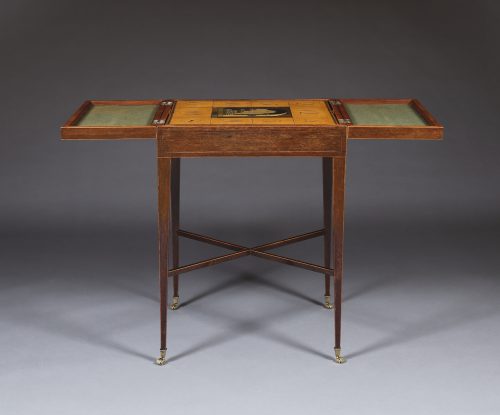
Research:
Of partridgewood. The hinged top inlaid with a continuous inlaid geometric border concealing a panel inlaid to one side for chess, and painted to the reverse with the game of Glückshaus enclosing a leather lined frieze compartment for backgammon, raised on square tapering legs connected by an X-strecher and terminating in gilt brass spade foot.
In the nineteenth century, the passion for games and gambling could be enjoyed in the home with an increase among the middle class in income and leisure time. The present games table represents an example of the small and lightweight, occasional tables made for this purpose, which could be easily brought in and moved around reception rooms.
The hinged table top opens to reveal a reversible gaming board inlaid on one side with a chess board, and painted on the other with a 19th century version of Glükshaus (House of Fortune), a 15th-16th century German gambling game. Players take turns rolling two die, and if the result matches a numbered square on the board, the player may collect the money from it. If the square is empty, the player must put down an amount. There are a variety of exceptions to these rules, most notably when a player rolls the number 7, whose special location in the center of the board signifies a “marriage” (Hochzeit) and requires a player to contribute to the “dowry.” This jackpot cannot be collected until a 12 (or “king”) is rolled.
Beneath the reversible panel are two compartments forming a backgammon board. Game pieces, dice, and other gaming appurtenances can be stored in these compartments when not in use.
The use of rare exotic South American partridgewood (Andira inermis) confirms that the table was an expensive private commission.
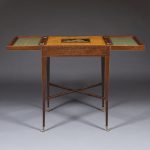

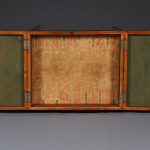
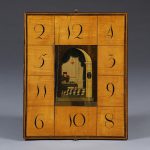
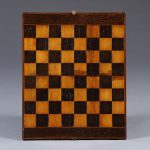


Comments are closed.